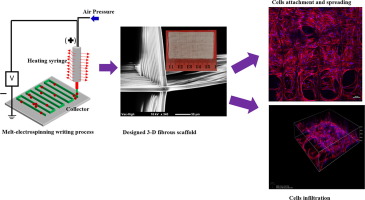当前位置:
X-MOL 学术
›
Eur. Polym. J.
›
论文详情
Our official English website, www.x-mol.net, welcomes your feedback! (Note: you will need to create a separate account there.)
Novel Polycaprolactone /Hydroxyapatite Nanocomposite Fibrous Scaffolds by Direct Melt-Electrospinning Writing
European Polymer Journal ( IF 6 ) Pub Date : 2018-08-01 , DOI: 10.1016/j.eurpolymj.2018.05.034 Abdalla Abdal-hay , Naghmeh Abbasi , Marcin Gwiazda , Stephen Hamlet , Saso Ivanovski
European Polymer Journal ( IF 6 ) Pub Date : 2018-08-01 , DOI: 10.1016/j.eurpolymj.2018.05.034 Abdalla Abdal-hay , Naghmeh Abbasi , Marcin Gwiazda , Stephen Hamlet , Saso Ivanovski

|
Abstract Melt electrospinning writing (MEW) using an automated stage has recently been developed as a direct additive manufacturing method for the fabrication of orderly, precise and complex porous 3D fibrous structures that can promote cell infiltration and growth. The further incorporation of inorganic particles within fibrous scaffolds is desirable in order to enhance bioactivity, however this remains challenging with the MEW fabrication process. To address this challenge, flexible, osteoconductive, medical grade polycaprolactone (m-PCL) - hydroxyapatite (HAp) composite 3D fibrous structures with high porosity (96–98%) and fully interconnected pore architectures were fabricated using MEW under precisely controlled parameters. The physical properties of these 3D fibrous composite scaffolds including fibre size, mechanical characteristics, and in vitro degradation rate were investigated. The results showed that the composite m-PCL/HAp fibrous scaffolds degraded in an alkaline environment at 37 °C faster than plain m-PCL and provided a favourable platform for the infiltration and growth of human osteoblasts. Moreover, confocal imaging confirmed that the scaffolds contained HAp nano-particles (NPs) which induced a more homogeneous distribution of cells within the scaffold particularly after 7 days of culture. Osteoblast activity and viability in the m-PCL/HAp composite scaffolds indicated a favourable cell/material interaction, suggesting great potential for use in mineralised tissue reconstruction / regeneration applications.
中文翻译:

新型聚己内酯/羟基磷灰石纳米复合纤维支架通过直接熔融电纺书写
摘要 使用自动化阶段的熔体静电纺丝 (MEW) 最近被开发为一种直接增材制造方法,用于制造有序、精确和复杂的多孔 3D 纤维结构,可以促进细胞浸润和生长。为了增强生物活性,需要在纤维支架中进一步掺入无机颗粒,但这对 MEW 制造过程仍然具有挑战性。为了应对这一挑战,使用 MEW 在精确控制的参数下制造了具有高孔隙率 (96-98%) 和完全互连的孔结构的柔性、骨传导性、医用级聚己内酯 (m-PCL)-羟基磷灰石 (HAp) 复合 3D 纤维结构。这些 3D 纤维复合支架的物理特性包括纤维尺寸、机械特性、和体外降解率进行了研究。结果表明,复合 m-PCL/HAp 纤维支架在 37°C 碱性环境中的降解速度比普通 m-PCL 快,为人成骨细胞的浸润和生长提供了有利的平台。此外,共聚焦成像证实,支架含有 HAp 纳米颗粒 (NPs),尤其是在培养 7 天后,支架内的细胞分布更均匀。m-PCL/HAp 复合支架中的成骨细胞活性和活力表明细胞/材料相互作用良好,表明其在矿化组织重建/再生应用中具有巨大潜力。结果表明,复合 m-PCL/HAp 纤维支架在 37°C 碱性环境中的降解速度比普通 m-PCL 快,为人成骨细胞的浸润和生长提供了有利的平台。此外,共聚焦成像证实,支架含有 HAp 纳米颗粒 (NPs),尤其是在培养 7 天后,支架内的细胞分布更均匀。m-PCL/HAp 复合支架中的成骨细胞活性和活力表明细胞/材料相互作用良好,表明其在矿化组织重建/再生应用中具有巨大潜力。结果表明,复合 m-PCL/HAp 纤维支架在 37°C 碱性环境中的降解速度比普通 m-PCL 快,为人成骨细胞的浸润和生长提供了有利的平台。此外,共聚焦成像证实支架含有 HAp 纳米颗粒 (NPs),尤其是在培养 7 天后,支架内的细胞分布更均匀。m-PCL/HAp 复合支架中的成骨细胞活性和活力表明细胞/材料相互作用良好,表明其在矿化组织重建/再生应用中具有巨大潜力。共聚焦成像证实,支架含有 HAp 纳米颗粒 (NPs),尤其是在培养 7 天后,支架内的细胞分布更均匀。m-PCL/HAp 复合支架中的成骨细胞活性和活力表明细胞/材料相互作用良好,表明其在矿化组织重建/再生应用中具有巨大潜力。共聚焦成像证实,支架含有 HAp 纳米颗粒 (NPs),尤其是在培养 7 天后,支架内的细胞分布更均匀。m-PCL/HAp 复合支架中的成骨细胞活性和活力表明细胞/材料相互作用良好,表明其在矿化组织重建/再生应用中具有巨大潜力。
更新日期:2018-08-01
中文翻译:

新型聚己内酯/羟基磷灰石纳米复合纤维支架通过直接熔融电纺书写
摘要 使用自动化阶段的熔体静电纺丝 (MEW) 最近被开发为一种直接增材制造方法,用于制造有序、精确和复杂的多孔 3D 纤维结构,可以促进细胞浸润和生长。为了增强生物活性,需要在纤维支架中进一步掺入无机颗粒,但这对 MEW 制造过程仍然具有挑战性。为了应对这一挑战,使用 MEW 在精确控制的参数下制造了具有高孔隙率 (96-98%) 和完全互连的孔结构的柔性、骨传导性、医用级聚己内酯 (m-PCL)-羟基磷灰石 (HAp) 复合 3D 纤维结构。这些 3D 纤维复合支架的物理特性包括纤维尺寸、机械特性、和体外降解率进行了研究。结果表明,复合 m-PCL/HAp 纤维支架在 37°C 碱性环境中的降解速度比普通 m-PCL 快,为人成骨细胞的浸润和生长提供了有利的平台。此外,共聚焦成像证实,支架含有 HAp 纳米颗粒 (NPs),尤其是在培养 7 天后,支架内的细胞分布更均匀。m-PCL/HAp 复合支架中的成骨细胞活性和活力表明细胞/材料相互作用良好,表明其在矿化组织重建/再生应用中具有巨大潜力。结果表明,复合 m-PCL/HAp 纤维支架在 37°C 碱性环境中的降解速度比普通 m-PCL 快,为人成骨细胞的浸润和生长提供了有利的平台。此外,共聚焦成像证实,支架含有 HAp 纳米颗粒 (NPs),尤其是在培养 7 天后,支架内的细胞分布更均匀。m-PCL/HAp 复合支架中的成骨细胞活性和活力表明细胞/材料相互作用良好,表明其在矿化组织重建/再生应用中具有巨大潜力。结果表明,复合 m-PCL/HAp 纤维支架在 37°C 碱性环境中的降解速度比普通 m-PCL 快,为人成骨细胞的浸润和生长提供了有利的平台。此外,共聚焦成像证实支架含有 HAp 纳米颗粒 (NPs),尤其是在培养 7 天后,支架内的细胞分布更均匀。m-PCL/HAp 复合支架中的成骨细胞活性和活力表明细胞/材料相互作用良好,表明其在矿化组织重建/再生应用中具有巨大潜力。共聚焦成像证实,支架含有 HAp 纳米颗粒 (NPs),尤其是在培养 7 天后,支架内的细胞分布更均匀。m-PCL/HAp 复合支架中的成骨细胞活性和活力表明细胞/材料相互作用良好,表明其在矿化组织重建/再生应用中具有巨大潜力。共聚焦成像证实,支架含有 HAp 纳米颗粒 (NPs),尤其是在培养 7 天后,支架内的细胞分布更均匀。m-PCL/HAp 复合支架中的成骨细胞活性和活力表明细胞/材料相互作用良好,表明其在矿化组织重建/再生应用中具有巨大潜力。



























 京公网安备 11010802027423号
京公网安备 11010802027423号